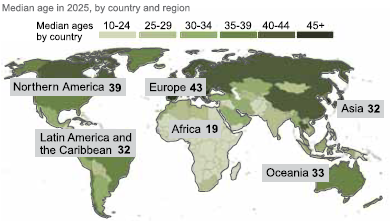Fique por dentro das novidades
Inscreva-se em nossa newsletter para receber atualizações sobre novas resoluções, dicas de estudo e informações que vão fazer a diferença na sua preparação!
Questão ativa
Já visualizadas
Não visualizadas
Resolução pendente
Questão anulada
Sem alternativas

Leia o texto para responder às questões de 21 a 25.
Global population growth is expected to slow between now and 2100. The population more than tripled in the last 75 years, but the United Nations (UN) expects it to grow by only about 1.9 billion between now and 2100 (from 8.2 billion to 10.2 billion). The population is expected to peak at 10.3 billion in 2084 and then decline to 10.2 billion through the end of the century.
The world’s three most populous countries in 2025 are expected to have radically different trajectories in the coming decades. Those countries are India (which has about 1.5 billion people today), China (1.4 billion) and the United States (347 million). India is expected to continue growing until it peaks at 1.7 billion people in 2061. Then it’s expected to gradually decline to 1.5 billion by 2100. China’s population has begun to shrink. It is projected to fall sharply to 633 million by 2100. Meanwhile, the United States (US) population is expected to grow slowly and steadily to 421 million by 2100.
Also, the world’s population is expected to get older. The world’s median age is projected to rise to 42 by 2100, up from 31 today and 22 in 1950. The number of people ages 65 and older is expected to more than double, from 857 million today to 2.4 billion by 2100. That would increase their share of the global population from 10% to 24%. By 2100, the world is expected to have roughly equal shares of people under 25 and people 65 and older. That would be a major shift from today, when younger people outnumber older adults by about four-to-one. In 1950, that gap was even wider, at about ten-to-one.

Looking at countries rather than regions, the median age in the US is 39. It ranks among the oldest third of countries globally but is slightly younger than many high-income countries in Europe and East Asia.
(Manolo Corichi et al. www.pewresearch.org, 09.07.2025. Adaptado.)
According to the third paragraph, by 2100, the
share of people 65 and older and people under 25 will reach a notable demographic balance.
proportion of people 65 and older in the global population will considerably decrease.
share of people under 25 will be 10% larger than that of people 65 and older.
global birth rate will drastically decline due to health policies directed at people under 25.
share of people 65 and older will significantly outnumber the share of people under 25.
A alternativa A afirma que “de acordo com o terceiro parágrafo, até 2100, a parcela de pessoas com 65 anos ou mais e de pessoas com 25 anos alcançará um equilíbrio demográfico notável”. O texto coloca: “Até 2100, espera-se que o mundo tenha parcelas aproximadamente iguais de pessoas abaixo de 25 anos e de pessoas com 65 anos ou mais”.
Inscreva-se em nossa newsletter para receber atualizações sobre novas resoluções, dicas de estudo e informações que vão fazer a diferença na sua preparação!